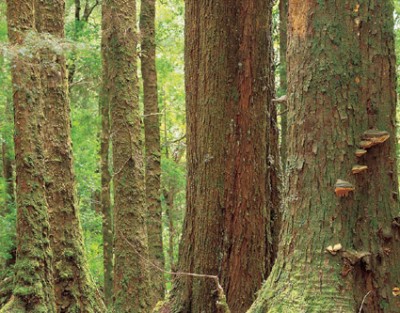The capacity of mature native forests to store carbon is a valuable asset that we need to preserve. [11 December 2007 | Peter Boyer]
You could say that the relationship between trees and us humans is a knotty one.

Forest scientists have found that a mature forest can store many hundreds of tonnes of carbon per hectare, in trees, understorey, leaf-litter and soil.
We love trees for their natural beauty and the protection they give from sun, wind and rain. And we destroy them for firewood, timber or paper, or to clear land for grazing or cropping or housing, or just to give ourselves a view.
In Australia’s wide brown land – and in Tasmania – the relationship has figured especially prominently. For 200 years, we European Australians have progressively denuded our coastal hills and interior flatlands of tree cover to meet a steadily-rising demand for timber and cleared land.
For me, a child of mid-20th century rural Tasmania, felling trees was a part of growing up. I took pride in my axemanship, such as it was, in the name of clearing the land and (best of all) using the brush to make enormous bonfires. Those were the days.
My family’s farming heritage taught me that land clearing was natural and trees were often a nuisance. There were so many trees that the idea of conserving them never occurred to us.
The nature conservation movement began warning us in the 1970s that, beyond timber and paper, trees had intrinsic and environmental values that justified leaving them alone. Now, forest scientists have determined that trees can be powerful tools in our struggle against global warming.
Plants remove carbon from the atmosphere and store it, and trees store it in large quantities. In looking at trees’ carbon-sequestering abilities, scientists have focused on the storage capacity of existing forests and the rate at which growing trees can absorb it.
Australian research has shown that mature native forests store more carbon than any other, in soils, leaf litter and understorey, but mainly in larger trees. On the other hand, older trees don’t have as much capacity to absorb carbon as younger, growing forests.
Removing the old forest and replacing it with a new one is not a solution. Clear-felling a forest releases so much carbon from soils, leaf-litter, understorey and trees that it takes 150 years to return to 90 percent of the forest’s original carbon carrying capacity.
Selective logging, which involves less soil disturbance, is one lower-impact solution – especially if the resulting product is timber, which will continue to store the trees’ carbon.
Another is to make charcoal from remnants of logged forests, which can then be stored in soils to provide agriculture with a slow-release source of fertilising carbon. This idea – agrichar – is a whole story on its own which I’ll return to in coming weeks.
If we are to plant new forests, it’s a much better option from a climate perspective if we plant them on long-cleared land. In other words, rather than replacing our carbon-rich native forests, we need to make new ones elsewhere.
Nothing is simple in this business. As we’re now well aware, in planting new forests we need to take account of social and water-supply issues. But the underlying message remains: trees are a lifeline, and we should treat them with great care.
